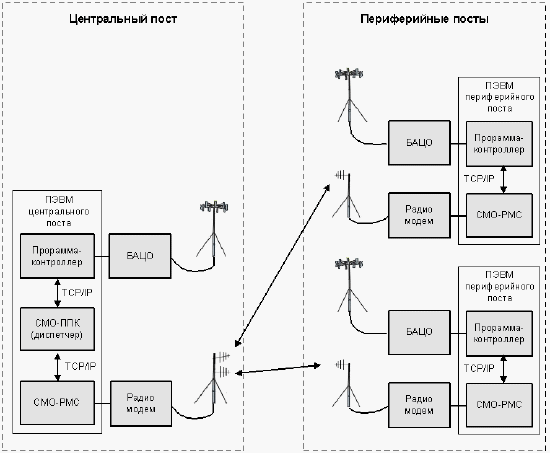
Equipment control and operating modes of the portable radio monitoring system and determination of the location of radio emission sources..
ASHIKHMIN Aleksandr Vladimirovich, Candidate of Technical Sciences
KOZMIN Vladimir Alekseevich, Candidate of Technical Sciences, Associate Professor
REMBOVSKY Yuri Anatolyevich, Candidate of Physical and Mathematical Sciences
CONTROL OF EQUIPMENT AND OPERATING MODES OF A PORTABLE SYSTEM FOR RADIO MONITORING AND LOCATION OF RADIO EMISSION SOURCES
This work is a continuation of the article [1], which outlined the general principles of constructing a portable system for radio monitoring and determining the location of radio emission sources (RES) ARK-POM3, the features of its main component — radio receiving equipment for monitoring and direction finding. This article examines the issues of interaction between territorially distributed posts of the system, as well as the features of its operation.
Control of peripheral posts via radio channel
The ARC-POM3 system consists of deployable central and peripheral posts. The posts include receiving radio equipment, as well as digital data exchange facilities [1]. In addition to performing radio monitoring functions and determining the location of the IRI, the central post provides remote control of the peripheral posts.
A radio network with a “star” topology is used to organize data exchange in the ARC-POM3 system. According to this topology, the peripheral posts of the system can exchange data only with the central post.
The central post is designated as the main one. Its PC controls the operation of the entire system, processes and displays information received from other posts. The special mathematical support of the panoramic direction-finding complex SMO-PPK, operating on the central post PC, has dispatch functions for controlling remote radio equipment posts using the TCP/IP protocol. Based on commands received from the central post, the controller programs of the peripheral posts control the operation of the radio equipment and send the results of radio monitoring to the central post.
Using high-speed radio channels
Modern high-speed radio modems provide data transfer rates of 10 Mbit/s and higher. In this case, there are no restrictions on the operation of peripheral post equipment related to low data transfer rates. All possible equipment modes are supported, including the transfer of instantaneous spectra, time samples of signals, audio files, correlation curves in direction finding mode, etc.
However, the use of external high-speed radio modems in the ARC-POM3 system is not always possible due to their high cost, often significant dimensions of directional antenna systems, and the requirement for the mandatory presence of a PC in the peripheral post.
Using low-speed radio channels
An alternative way of data exchange is to use low-speed radio data transmission channels. Such radio channels are organized with the help of radio modems, the data transmission speed of which is usually from 1200 to 25,600 bits/s.
Many commercial and military radio stations have external modems for transmitting digital data. As an example, we can name domestic radio stations of the Akveduk P168E family, whose built-in modems are capable of transmitting digital data at a speed of up to 16,000 bits/s. The range of specialized narrow-band low-speed radio modems suitable for use in a portable system is also quite wide, for example, IntegraTR or T-96SR radio modems manufactured by DataRadio are suitable for this purpose.
Fig. 1 shows the ARC-POM3 system consisting of three posts. The figure corresponds to the case when the peripheral posts are equipped with a PC. In the case when there is no PC in the peripheral post, the radio modem is connected directly to the analog-to-digital signal processing unit (ADSP) [1].
Fig. 1. Control of peripheral posts
The SMO-RMS program (special mathematical support for radio modem communication) controls the operation of radio modems in accordance with the exchange protocol, converts TCP/IP data into compressed form.
The typical distance between posts is about 3 – 10 km, it depends on the power of the radio modems used and is usually limited by the direct visibility between posts.
SR protocol for transmitting data over a radio line
Radio stations and low-speed autonomous radio modems usually use simplex or half-duplex transmission methods, which make it impossible to simultaneously transmit and receive information. Therefore, there is an additional decrease in the exchange rate due to the time it takes to enter into communication when changing the direction of data transmission from the central post to the peripheral post and vice versa. The typical time it takes to enter into communication for narrowband radio modems is from 30 to 150 milliseconds. In order to increase the data transmission rate over a low-speed radio line, a packet protocol implementing the SR (Selective Repeat) method has been developed for the ARC-POM3 system. The protocol takes into account the main features of a narrowband radio line:
- the line provides sequential data transmission;
- simplex or half-duplex transmission is used;
- establishing a connection and changing the direction of transmission takes a significant amount of time;
- during transmission, individual bytes may be distorted.
The protocol is characterized by the fact that data are transmitted in frames consisting of a large number of packets of limited length. Each packet transmits its number and the CRC (Cyclic Redundance Check) check value. On the receiving side, the packet check value is again calculated based on the received data. If the calculated CRC does not match the transmitted value, the packet is considered to be faulty. After the frame is completed, the transmission direction changes: the receiving side sends a confirmation of receipt in the return frame, which contains the numbers of incorrectly transmitted packets, if any. Data that must be sent from the receiving side to the transmitting side is also placed here. Thus, one frame contains both service information about received packets and new data, thereby reducing the number of connections. The transmission of faulty packets is repeated. If all packets are received without errors, the frame transmission is complete. The transmitting side, which has not received confirmation of frame reception within a specified period of time (timeout) after transmission, resends the frame. To operate in a network consisting of more than two radio modems, the frame transmitted by the central post contains a marker that allows a response to the radio modem with a given number.
The selective repeat protocol minimizes the number of entries into communication and increases the capacity of the radio link. For example, for a radio link of 5 km length based on narrowband T-96SR modems, the rate of transmission of bearings increased almost twice as compared to the usual block protocol.
Photo 1 shows a radio modem of a peripheral post of the ARK-POM3 system deployed on a folding mast. A directional antenna is used to increase the range, the TR-965SR radio modem itself is fixed in a special protective casing on the base of the mast (photo 2).
If there are several peripheral posts in the system, then the point-to-multipoint radio communication method is implemented. A non-directional antenna or several directional antennas with a matching device connected to one radio modem are installed at the central post. The peripheral posts receive all data from the central post, but only the post whose number matches the marker transmitted by the central post can transmit the results.
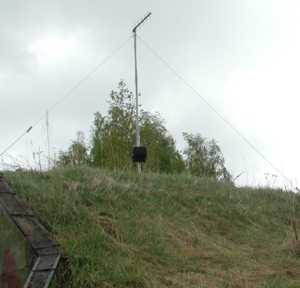
Photo 1. Radio modem on a mast with a directional antenna
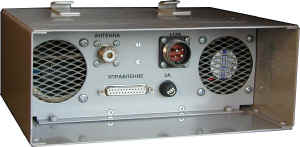
Photo 2. Radio modem in a protective casing
Using radio modems for mobile cellular radio communication systems
If the area of operation of the ARC-POM3 system is in the coverage area of a cellular radio communication system that provides data transmission services, then another way to organize control in the system is based on the use of radio modems for cellular mobile systems. Such a solution has significant advantages:
- in cellular communication systems, the terminal radio equipment has a small weight and dimensions, which is very attractive for use in a portable system;
- the range is determined by the coverage area of the cellular radio communication system;
- as a rule, masts and directional antennas are not required;
- a duplex transmission method is possible, in which transmission and reception are carried out simultaneously, which doubles the bandwidth of the communication channel;
- there is no need to use the SR data transmission protocol.
Accordingly, there are also some disadvantages:
- if a commercial cellular radio network is used, then costs associated with the need to pay for the services of a cellular operator are inevitable;
- there is a dependence of the operability of the ARC-POM3 system on the operability of the cellular radio communication system and its coverage area.
At present, GSM standard cellular radio communication systems have become widespread. These systems actively use GPRS (General Packet Radio Service) technology, designed for packet data transmission via radio channels. Theoretically, when using all the capabilities of the cellular system, the data transfer rate can exceed 100 kbps, but in practice it greatly depends on the degree of load on the mobile network and the characteristics of the operator providing the services. In addition, GPRS requires the presence of a PC in the peripheral post, which is not always possible. Therefore, the ARC-POM3 system uses direct channel switching for data transmission. This method allows for a point-to-point connection between the central and each of the peripheral posts. Data transmission occurs in duplex mode at a speed of 9600 bit/s, which is quite acceptable for the system operation.
Choosing the preferred option for data transmission
Thus, in the ARC-POM3 system, three options for organizing radio exchange between posts can be used:
- using high-speed radio modems;
- using low-speed radio modems operating autonomously;
- using radio modems of cellular radio communication systems.
Which option is preferable? Obviously, it is determined by many factors, from the cost of the system, specific requirements for it, and ending with the conditions of its operation. According to the authors of the article, high-speed radio modems are more suitable for posts deployed for a long time; they ensure the implementation of all possible hardware and software functions at peripheral posts. For a military system, autonomous radio modems or radio modems of military radio communication and control systems are more suitable. For civilian systems, a control option based on modems of commercial cellular systems is preferable.
Any of the three data exchange options allows you to increase the number of stationary posts in the system and introduce mobile radio monitoring and direction finding stations that operate on the move.
Software of the ARK-POM3 system
The minimum software set consists of three software packages of special mathematical support SMO-PPK, SMO-RMS and SMO-KN “Stalker”. The package of special mathematical support for panoramic analysis and direction finding SMO-PPK contains the SMO-PPK program and the equipment controller program.
The SMO-RMS package (communication via radio modems) is responsible for data transfer between posts using low-speed radio modems, as well as CDMA or GSM cellular radio network modems. In addition, the SMO-RMS program ensures control of the communication line serviceability and the exchange of text messages between the operators of peripheral posts and the operator of the central post. The appearance of the SMO-RMS program window is shown in Fig. 2.

Fig. 2. Appearance of the main window of the SMO-RMS program
In case of using high-speed radio communication lines, there is no need for the SMO-RMS program, since the exchange between the SMO-PPK program and remote controllers is carried out directly via the TCP/IP protocol.
The SMO-KN (cartography and navigation) “Stalker” package provides work with an electronic map of the area, plotting bearings, automatic determination of the location of the IRI based on direction finding data received from the SMO-PPK program or entered manually.
Additionally, the software may include the SMO-ASPD spectral-direction finding data processing program and the SMO-STA radio signal technical analysis program.
Features of the ARC-POM3 system operating modes
Regardless of whether there are PCs at the peripheral posts or not, the SMO-PPK program of the central post supports the following modes: Spectrum, Search, Background Scanning, Panorama, Playback, Measurement Scanning, Bearing, and Multichannel Bearing Finding. The purpose and capabilities of these modes were discussed in sufficient detail in [2, 3], so in this article we will only focus on the features of their implementation as part of the ARC-POM3 system.
We will assume that the peripheral posts are controlled via low-speed radio channels.
The “Spectrum” mode is designed to display spectral panoramas of radio signals in specified frequency bands. To obtain a spectrum, you can use the equipment of the central or any peripheral post. When using the equipment of the central post, all the functions of the “Spectrum” mode are available, including automatic search for new signals, listening to and recording radio broadcasts. If the equipment of a peripheral post is used, then only display of the spectrum in the specified ranges is available. In this case, the display speed is determined by the throughput of the low-speed radio line; it is significantly less than the speed of spectral analysis performed by the equipment of the central post.
The Spectrum mode has a Search submode that searches for active or new sources of radio signals [2]. In the ARC-POM3 system, it is advisable to use this mode together with the Background Scanning mode. In this case, the distribution of tasks between the posts occurs as follows. The equipment of the central post, in accordance with the selected algorithm, searches for new or currently active radio communication channels. When the next active channel is detected, the search process is briefly interrupted for a single scan at the frequency of the detected channel. In this case, any combination of the bearing value, a “photograph” of the spectrum of the detected source, an audio sample, and a time sample of the signal at an intermediate frequency can be specified as the response returned by the equipment of the central post. Peripheral posts can return only the bearing value and the signal amplitude in order to reduce the volume of transmitted data. After scanning, the search is resumed.
The “Peleng” mode is used to receive synchronous bearings from all system posts on a given frequency, and to listen to and record radio transmissions. In this mode, the post equipment carries out the bearing of the IRI on one frequency. Fig. 3 shows the SMO-PPK program window in the “Peleng” mode for the ARK-POM3 system, consisting of two posts.
The figure shows the direction finding of the GSM base station. The central station of the system receives the values of the spectrum and bearings, while the peripheral station receives only the values of the bearings and signal amplitudes. The PC screen displays the spectrum received from the central station and the bearings received from all peripheral stations. The history of bearings and the history of signal amplitudes are displayed, which allows us to evaluate the dynamics of changes in the parameters of the RES over time. It is possible to display the spectrum from any peripheral controller, but in this case the direction finding speed will decrease sharply.
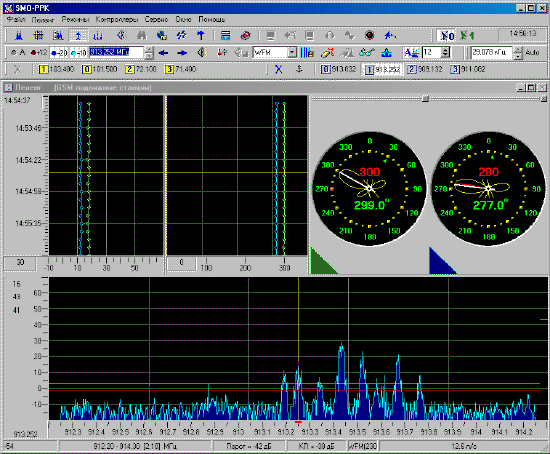
Fig. 3. “Bearing” mode
The “Peleng” mode is designed for synchronous direction finding of the RES with the operator-set central frequency and spectrum bandwidth. The rate of receipt of bearings from the peripheral post depends on the quality of the radio link. In the simplex radio communication mode and the use of autonomous radio modems with a data transfer rate of 19,200 bits/s, 5–8 bearings per second can be received from the peripheral post.
The “Scanning” mode differs from the “Background scanning” mode in that it performs cyclic scanning of the RES in accordance with the specified list of frequencies.
If the peripheral posts of the system include a PC, then the Multichannel Direction Finding mode acquires special significance in the ARK-POM3 system. This mode is supported in the Spectrum mode as a type of active channel search. The mode is intended for automatic direction finding of active radio emission sources in a given range (or frequency ranges).
In multichannel direction finding, the equipment of the posts is successively tuned in frequency from the lower limit to the upper limit of the task. The tuning step is equal to the passband of the digital processing path, which, depending on the modification of the receivers, is 2, 5 or 10 MHz. At each tuning frequency, the signal processor of the receiver calculates complex spectra of signals in the entire passband. Based on the calculated complex spectra, signals of all active RES are detected and taken into bearings. For each RES, the central frequency, band, amplitude of the spectral components of the signal, azimuth and angle of arrival of the radio wave are estimated.
The speed of obtaining a bearing panorama depends on the speed of the radio receiving equipment and the direction finding algorithm. For equipment based on ARGAMAK receivers with a bandwidth of 5 MHz and a nine-element receiving antenna array, when taking direction of signals at the sensitivity level of the receiver, it is at least 200 MHz/s. In this case, in one 5 MHz band there may be up to 200 taken sources with a spectrum width of 25 kHz. It becomes practically impossible to transmit the entire volume of data received by peripheral posts during multi-channel direction finding via low-speed radio lines. Therefore, the results of multi-channel direction finding at peripheral posts are recorded in compressed form in special spectral-direction finding data files (SPD files).
The transmission of bearing results from the peripheral posts of the system to the central post is carried out only at the request of the central post. The request specifies the time interval for which it is necessary to transmit bearings, as well as the frequency and band of the signal. In practice, this operation is carried out as follows. At the central post, the results of multichannel bearing obtained from the equipment of the central post are displayed in the database table of the “Search” window. The operator selects the frequency of the required IRI in the “Search” window and, using a combination of hot keys, gives the command to transmit bearings from peripheral posts. At the peripheral posts, the “required” bearings are extracted from the SPD files and transmitted to the central post.
Fig. 4 shows the window of the SMO-PPK program in the “Multi-channel direction finding” mode for the ARK-POM3 system consisting of two posts. The window displays a table of detected channels, the bearing value, and the current spectrum in the direction finding range.
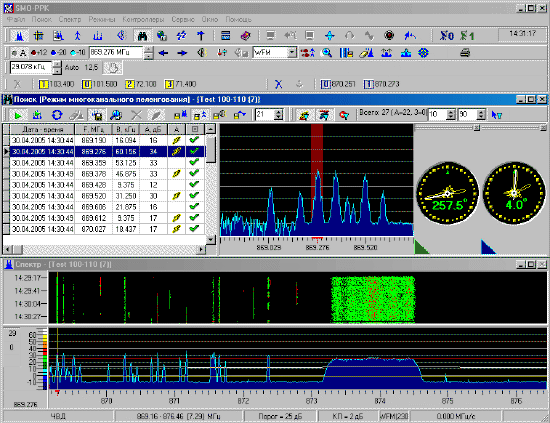
Fig. 4. The window of the SMO-PPK program in the “Multi-channel direction finding” mode
The “Multi-channel direction finding” mode provides automatic direction finding of all radio-electronic sources whose frequencies correspond to the set task. The mode is convenient for opening and long-term monitoring of the electronic environment.
For additional deferred processing of SPD files accumulated at the system posts, the SMO-ASPD program is used. It displays spectral and direction-finding data in the form of corresponding diagrams with adjustable resolution by frequency, time and angle sector. It can be used to search for radio sources by time, frequency or in a given sector of azimuth angles, evaluate the intensity of radio communication and determine the load of various radio ranges. The SMO-ASPD program window is shown in Fig. 5.
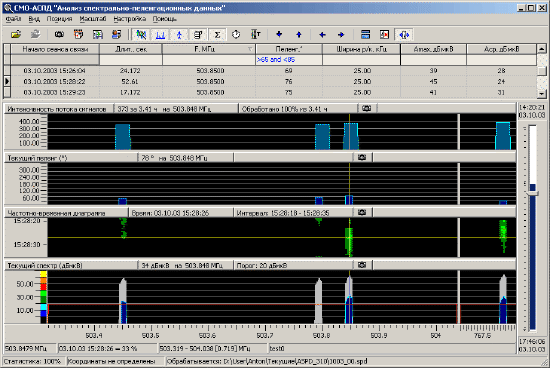
Fig. 5. SMO-ASPD program window in the SPD file post-processing mode
The results of direction finding from the SMO-PPK program are transferred to the SMO-KN “Stalker” cartographic application, which is a specialized geographic information system. The program shows the location of the IRI, their movement routes (in the case of mobile sources), records the positions of the direction finders and the received bearings in the history file. Fig. 6 shows the SMO-KN Stalker program window with the results of determining the location of a stationary IRI.
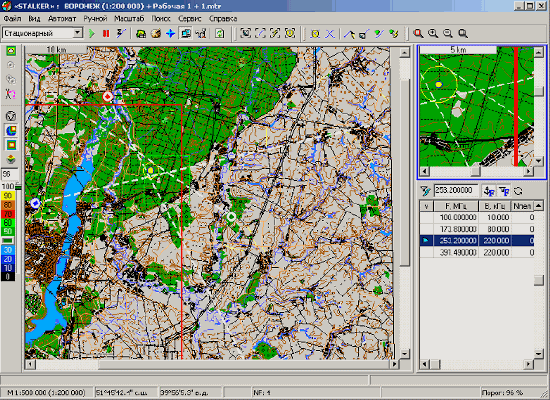
Fig. 6. The window of the SMO-KN “Stalker” program in the mode of determining the location of a stationary IRI at a frequency of 253.2 MHz
The accuracy of positioning in open terrain is no more than 1.5% of the distance to the object. The system's range is largely determined by the terrain and the power of the radio source. The standard value of the range in open terrain for a 5 W radio source is 10 — 15 km. Thus, under the most unfavorable conditions, the positioning error is from 50 to 250 m.
Conclusion
Both high-speed and low-speed radio data transmission lines can be used to control the posts of the ARC-POM3 system. In the latter case, the system software reduces the amount of data transmitted between posts without degrading the functionality of direction finding and determining the location of the radio source.
The ARC-POM3 system is a multifunctional radio monitoring system, it is capable of performing not only synchronous direction finding and localization of radio sources on a terrain map, but also panoramic spectral analysis, signal search, listening to and recording radio broadcasts, recording radio signals on an intermediate frequency for subsequent processing, technical analysis of radio signals. The system has automatic modes for searching and direction finding active signals. The system allows for long-term monitoring of the radio-electronic environment, accumulating results in databases. Software for deferred processing provides statistical analysis of the results of digital spectral analysis, direction finding and determination of the location of radio sources.
The ARC-POM3 system is scalable, adding additional stationary or mobile posts to the system does not require changing the software.
The equipment for radio monitoring and direction finding of the system posts has high tactical and technical characteristics in terms of accuracy, sensitivity and dynamic range, which makes it possible to use the ARC-POM3 system not only in remote forest, mountain and rural areas, but also in large cities and industrial centers.
Literature
1. Ashikhmin A.V., Koz'min V.A., Rembovsky Yu.A. Portable system for radio monitoring and determination of the location of radio emission sources./Special equipment, 2005, No. 2, pp. 27 – 35.
2. Ashikhmin A.V., Koz'min V.A., Tokarev A.B., Stopkin V.M. Use of panoramic measuring receiver ARK-D1TR in mobile radio monitoring stations Argument-I./Special equipment, 2004, No. 5, pp. 38 – 49.
3. Ashikhmin A.V., Zhukov A.A., Kozmin V.A., Shadrin I.A., Localization of radio emission sources and measurement of field strength using a mobile radio monitoring station./Special equipment, 2003, Special issue, pp. 9 – 18.

Добавить комментарий